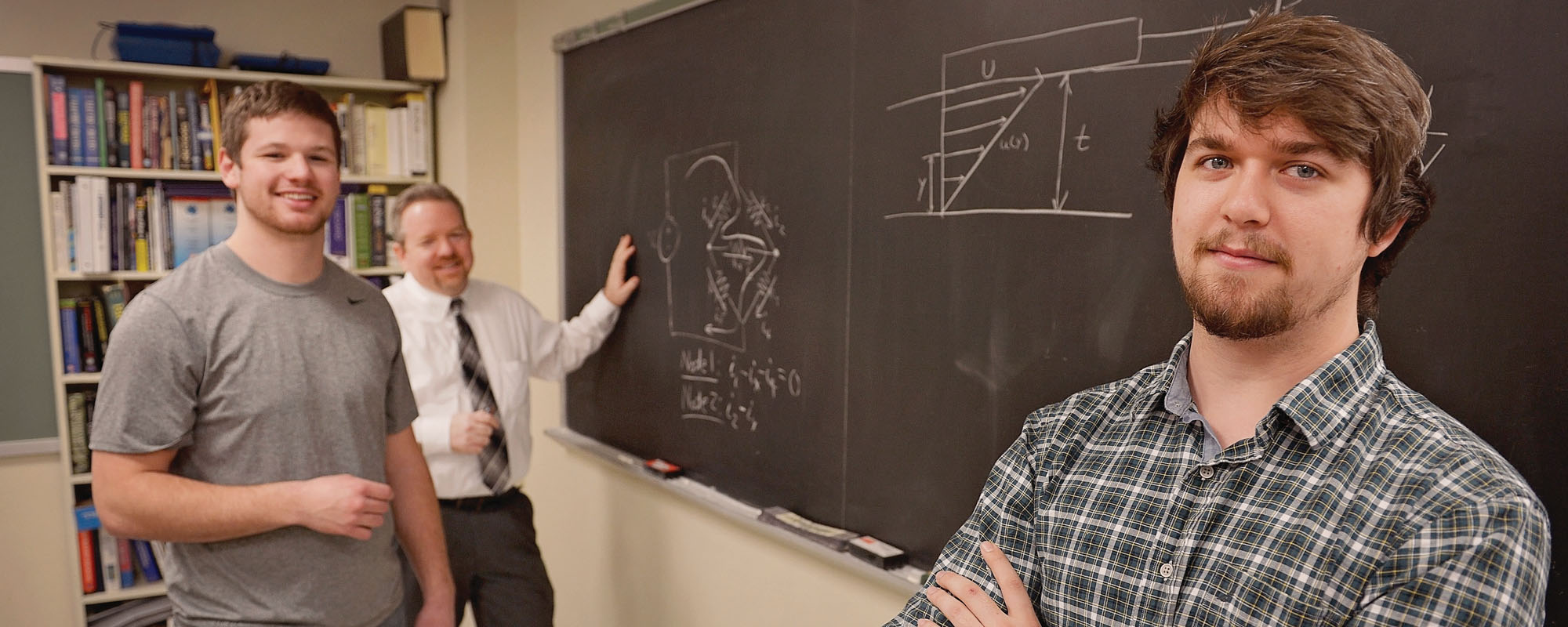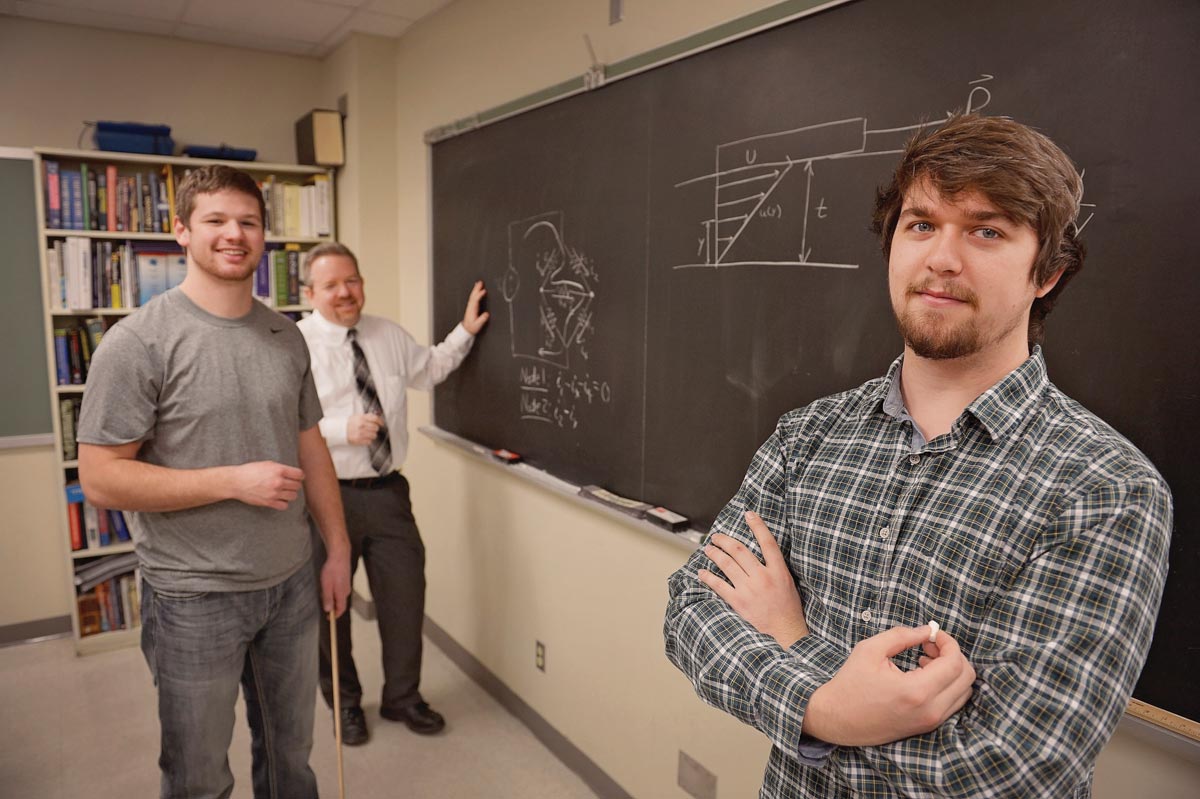Engineering often is the career choice for people who thrive when finding solutions to real-world problems, as the discipline requires the application of math and science to solve complex issues in a variety of industries.
Two problem-solving students are about to emerge with the first SFA four-year engineering physics degrees, two years after the launch of the program.
Cash Hamilton from Nacogdoches and Kasey Holland from The Woodlands are set to graduate in May with bachelor’s degrees in engineering physics, and both students say they have passion for the discipline.
“I have a desire and love for problem solving, and engineering requires a lot of discipline to do it,” Hamilton said. “Choosing it for a career came naturally.”
Holland also said the career choice was fairly simple. “I’ve always liked science and math, and combining those interests with creativity and innovation is what drew me to engineering,” he said.
Hamilton and Holland often are found working on projects in the SFA engineering labs, and those long hours have helped lead to their success.
“It’s a big deal to have graduates two years after starting a program,” said Dr. Dan Bruton, adviser for the engineering physics program. “The coordinating board expects you to have your first graduates four or five years after starting a program. Because we have had a successful pre-engineering program for so long, we were able to have our first two graduates in only two years.”
For decades, SFA has offered a pre-engineering program, in which students study for two years before transferring to another university to complete their degree. Alternatively, students often finish a physics degree at SFA and then seek work as an engineer.
“About half the students graduating with physics degrees from SFA are getting engineering positions,” Bruton said. “Their degrees didn’t say ‘engineering,’ so getting a license was more difficult. If you have an engineering degree from an accredited program, then it opens a lot of doors. You have broader job opportunities, and your income will probably be higher.”
Bruton has been part of a group that has sought to bring a four-year engineering program to SFA since 2002.
“The coordinating board said they had enough engineering programs in the state, but our students were saying otherwise,” Bruton said. “They wanted to go to a university in East Texas and receive their four-year engineering degrees. They wanted to stay at SFA.”
In April 2014, the coordinating board finally approved the program, and the department added new courses and faculty members.
Dr. Christopher Aul, a mechanical engineer, was one of the first new professors hired. He left his engineering job in Houston designing formation isolation valves for Schlumberger, a leading petroleum technology company, to help start the new program.
Working in the field, he saw a clear lack of supply for workforce demand.
“We need more engineers, simply put,” Aul said. “There are more jobs than engineers, and that trend continues. If you earn an engineering degree, you’re going to land a job.”
Hamilton and Holland were physics majors who planned on attaining engineering careers, and they were among the first students to enroll in the program when it began in the fall 2014 semester.
“Two years ago, our department chair, Dr. (Harry) Downing, sent me a photo of Cash Hamilton holding a degree plan,” Bruton said. “The message read ‘our first degree plan, and he likely will be our first graduate.’ I didn’t think he could predict that, but that is exactly what happened.”
Hamilton, who has focused on mechanical engineering, said he plans to meet with several corporations before deciding where he will take his first job.
Holland, who has concentrated on electrical engineering, is planning to study robotics in graduate school. Engineering physics programs can be an attractive undergraduate option for students who have an eye on furthering their education.
“Engineering physics works out better for graduate studies because of the emphasis on physics, and you’ll have a more high-end understanding,” Aul said. “When I was an undergraduate studying mechanical engineering, there were some blurred lines. It can be more of an applied science.”
Connor O’Leary, a sophomore engineering physics major from Plano, said he plans to pursue graduate studies. He initially planned on the pre-engineering program.
“They told me about the new four-year program during orientation,” O’Leary said. “After being here two years, it really feels like a community. The class sizes are smaller than at the larger universities, so you get more hands-on instruction. You know your professors and have opportunities to take part in projects. Now that there is a four-year program, I can get that experience for my entire degree.”
However, SFA’s pre-engineering program is still in demand because some students want to specialize in areas not offered at SFA.
“There are so many areas of engineering that we couldn’t possibly offer all of them,” Bruton said.
Aul said the first two years of most engineering degrees are similar.
“You need the foundational courses, and then you move into specialized areas,” Aul said.
The engineering physics program more than doubled in size during the first year, and Aul and Bruton anticipate continued growth.
“It was surprising to me how quickly the program took off,” Bruton said. “The number of students who are engineering physics majors is now equal to the number of physics majors. We now have more than 200 students with majors in our department, which is a record.”
The program will be housed in the new STEM building, which should open in 2018. Bruton said long-term plans include adding full mechanical, electrical and graduate engineering programs.
Aul said the program’s continued growth could help SFA fill the need for future problem solvers in the workforce.
“It’s an ‘if you build it, they will come’ type situation,” Aul said. “As people graduate and others see where they are getting jobs, the growth will continue. The new building is centered on student engagement, and it will be built for the future—a larger program.”



